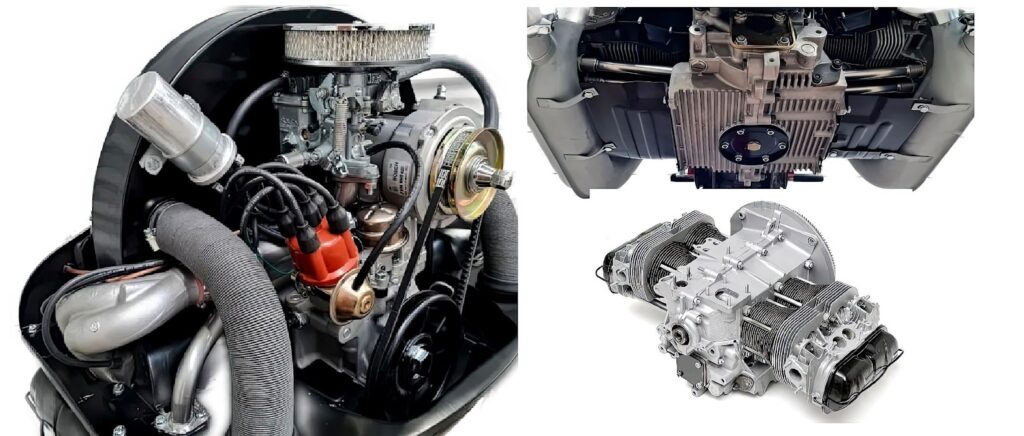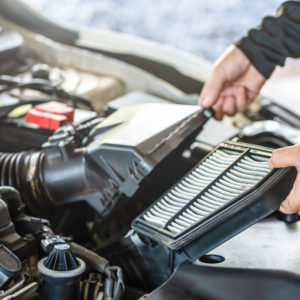When the internal combustion engine burns fuel to produce mechanical power, it generates heat. Extremely high temperatures can reduce performance and deform or damage engine parts, so the engine needs a way to vent excess heat as quickly as possible.
In this article, we will take a look at and compare a liquid-cooled engine vs. an air-cooled engine.
What Is An Air-Cooled Engine?
An air-cooled engine uses air circulation to dissipate heat from the combustion process. It features cooling fins on its cylinders and the piston cylinder head’s top to increase the surface area that radiates heat.
The cooling fins pull heat from the cylinders and release thermal energy from the engine. They make it possible for the latter to stay at safe operating temperatures.
While cooling fins improve passive heat dissipation, air-cooled engines, such as in motorcycles, receive a lot of airflow while the motorbike is traveling. Air rushes through the exposed cooling fins especially at higher speeds.
In other vehicles with air-cooled engines, a cooling fan pushes air through metal shrouds surrounding the fins because, unlike in a motorcycle, airflow from simply moving forward isn’t sufficient. In older vehicles, the fan draws power from the engine via a connective belt. Newer fans have an electric motor that runs on the vehicle’s power supply.

Advantages
Air-cooled engines have a few advantages. Their design enables low profiles with the cylinders laying flat on both sides of the engine’s crankshaft. This kind of engine is referred to as “horizontal opposed.” The flatter engine lowers the vehicle’s center of gravity, which improves stability while making sharp turns at high speed. Older sports cars like the Porsche 911 often used these flat engines to save weight.
If mounted in the back of a rear-wheel drive (RWD) vehicle, the air-cooled flat engine puts more weight on the rear wheels that drive the car. This weight distribution improves the drive wheels’ grip on the road surface.
Some air-cooled engines can divert some heated air to the vehicle’s interior through heat exchanging fins cast into shrouded exhaust parts. The hot air can help keep the vehicle’s occupants warm during cold weather.
Disadvantages
An air-cooled engine can struggle to dissipate high heat levels fast enough to keep a constant temperature. This problem often appears in hot weather, driving uphill or towing a trailer.
“As an experienced VW bug mechanic working with my dad at his bug shop in the ‘60s and ‘70s, I can tell you that air-cooled engines heat up a lot faster than fluid-cooled engines.”
–Richard McCuistian, ASE Certified Master Automobile Technician
Noise is another known problem of some air-cooled engines. They can sound louder than other engines. While some appreciate powerful sounds coming from their vehicle, others may not like the racket at three in the morning. Note, however, that most air-cooled engines run very quietly.
What Is a Liquid-Cooled Engine?
As its name indicates, the liquid-cooled engine uses liquid coolant to regulate its temperature. Some call it the water-cooled engine, but its cooling system doesn’t use pure water. Instead, the coolant is a mixture of water and antifreeze.
The liquid-cooled engine employs a closed-loop cooling system that runs efficiently even when the car isn’t moving. The system includes various parts that work together to keep the engine running within a safe temperature range.
A water pump moves coolant through the engine and cooling system. However, when the engine is cold, the coolant will bypass the thermostat to be directed through the heater core, providing cabin heat in wintertime.
Cabin heat on air-cooled engines is typically accomplished using shrouded fins on some of the exhaust parts, with the cooling fan forcing air across the fins and into the vehicle when the heater controls are open.
Liquid-cooled engines have a radiator. This heat exchanger usually features cooling fins similar to those on the cylinders of an air-cooled engine. The radiator removes heat from the coolant passing through its tubes and dissipates the thermal energy through its fins.
Radiators have a fan that forces air over their cooling fins. There are airflow dynamics involved, so the fan either doesn’t pull as much air or doesn’t work at all while the vehicle is traveling above certain speeds.
A thermostat controls the movement of coolant to and from the radiator. The thermostat ensures that cooling fluid enters the radiator at the right time and temperature and helps the liquid-cooled engine warm up more quickly.
Each of these parts plays a vital role in a water-cooled engine. The water pump moves coolant through the system, where the fluid can absorb the heat produced by the combustion process.
The thermostat monitors the coolant’s temperature. It prevents any flow to the radiator until the coolant gets hot enough. Then it opens the appropriate valve and lets hot liquid enter the radiator to cool off. This way, it keeps the engine coolant at a constant temperature, not too hot or cold.
Advantages
Water-cooled engines regulate their temperature better in different weather conditions. Whether it’s the summer heat or the chill of winter, water-cooled engines don’t lose much heat.
Disadvantages
A water-cooled engine takes up considerable space. It also weighs a lot. The increased size and weight come from the array of cooling system parts like the coolant reservoir, radiator, and water pump.
Difference Between Air-Cooled and Liquid-Cooled Engine
Engines are engineered to be cooled using the principles of heat transfer.
- Principle one is conduction, which means that heat travels through contact. The cylinder walls and the cylinder head are the hottest parts of any engine, so the head and cylinders will always either have an array of cooling fins cast into them or will have fluid circulating through or around them.
- Principle two is convection, where the heat is carried away by air and/or fluid.
- The third principle of heat transfer is radiation, which is how the sun warms the earth, but this principle is used more for heating than for cooling.
Small engines, including most motorcycles and a few cars, are air-cooled, typically with fins cast into the cylinders and heads. Motorcycles typically have their fins exposed to the air, but have no fan of any kind, because the motorcycle is usually moving through the air anyway.
Air-cooled lawn mowers and vehicle engines will have metal shrouds over their fins to direct airflow created by a fan.


Having said that, generally, water-cooled engines enjoy superior performance over air-cooled engines. They warm up faster, control their temperature more effectively, and run more efficiently. Most new and recently manufactured vehicles cool their engines with liquid coolant.
However, an air-cooled engine enjoys some advantages in specific applications. The small-capacity engines in classic and vintage cars use air-cooling systems.
Some engines combine the best of both cooling systems. They use a liquid cooling system with features borrowed from air-cooled engines, such as areas that rely on air circulation for heat dissipation. Their radiators are usually smaller, thinner, and lighter to reduce weight.
Where to Get Top-Notch Engine Components for Your Ride
To keep your vehicle running at its best, you have to make sure all of its engine components are working as they should. When you need replacement engine parts, it’s a good idea to shop here at CarParts.com.
We have a wide array of engine parts sold at unbeatable prices. You won’t have to break the bank just to get your vehicle back on the road.
Simply input the necessary details into our vehicle selector tool to narrow down the search results to parts compatible with your vehicle. You can also filter the products in our catalog according to your preferred brand or price range.
Do you have questions about fitment or shipping? Don’t hesitate to call our toll-free hotlines. Our team happily offers round-the-clock support for customers.
Make more memories with your vehicle by making sure its engine is well-maintained. Check out our selection of high-quality engine parts, and shop today!
Any information provided on this Website is for informational purposes only and is not intended to replace consultation with a professional mechanic. The accuracy and timeliness of the information may change from the time of publication.




























